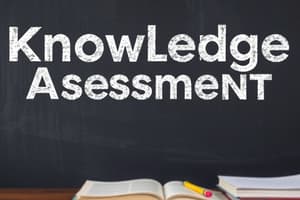Podcast
Questions and Answers
What's the difference between movement/mobility/functional mobility, physical activity and exercise?
What's the difference between movement/mobility/functional mobility, physical activity and exercise?
Movement/mobility/functional mobility refers to changes in the position of the body, physical activity is any movement generated by skeletal muscles that results in energy expenditure, and exercise is a planned, purposeful physical activity.
Define physical fitness.
Define physical fitness.
Physical fitness refers to the characteristics that enable a person to perform physical activity.
What are the health-related components of physical fitness? (Select all that apply)
What are the health-related components of physical fitness? (Select all that apply)
- Agility
- Flexibility (correct)
- Muscular endurance (correct)
- Body composition (correct)
- Cardiorespiratory endurance (correct)
- Balance
- Muscular strength (correct)
- Coordination
How do you address the health-related components of physical fitness?
How do you address the health-related components of physical fitness?
What are the skill-related physical fitness components? (Select all that apply)
What are the skill-related physical fitness components? (Select all that apply)
What are the three core recommendations of the Canadian 24-hour movement guidelines? (Select all that apply)
What are the three core recommendations of the Canadian 24-hour movement guidelines? (Select all that apply)
What is the only difference between the Canadian 24-hour movement guidelines for people aged 18-64 and people aged 65+?
What is the only difference between the Canadian 24-hour movement guidelines for people aged 18-64 and people aged 65+?
What's associated with a lower risk of mortality?
What's associated with a lower risk of mortality?
What's is the dose-response relationship between physical activity and health?
What's is the dose-response relationship between physical activity and health?
What are the health benefits associated with regular physical activity? (Select all that apply)
What are the health benefits associated with regular physical activity? (Select all that apply)
What's the link between physical inactivity and chronic diseases?
What's the link between physical inactivity and chronic diseases?
What contributes to the incidence of chronic diseases? (Select all that apply)
What contributes to the incidence of chronic diseases? (Select all that apply)
What's the difference between comorbidity and multimorbidity?
What's the difference between comorbidity and multimorbidity?
What are some barriers to exercise? (Select all that apply)
What are some barriers to exercise? (Select all that apply)
What should be included in a comprehensive exercise program? (Select all that apply)
What should be included in a comprehensive exercise program? (Select all that apply)
There is variability in individual responses to a standard dose of exercise.
There is variability in individual responses to a standard dose of exercise.
What is the SAID principle? How does this relate to the way you prescribe exercise?
What is the SAID principle? How does this relate to the way you prescribe exercise?
What are the mechanisms of adaptation? (Select all that apply)
What are the mechanisms of adaptation? (Select all that apply)
What are the neurological effects of exercise? (Select all that apply)
What are the neurological effects of exercise? (Select all that apply)
What are the functional effects of neurological adaptation? (Select all that apply)
What are the functional effects of neurological adaptation? (Select all that apply)
What are the metabolic effects of exercise? (Select all that apply)
What are the metabolic effects of exercise? (Select all that apply)
What are the specific skeletal muscle adaptations of exercise? (Select all that apply)
What are the specific skeletal muscle adaptations of exercise? (Select all that apply)
What are the specific cardiovascular adaptations of exercise? (Select all that apply)
What are the specific cardiovascular adaptations of exercise? (Select all that apply)
What's the main mechanism of adaptation in cardiovascular exercise?
What's the main mechanism of adaptation in cardiovascular exercise?
What's the FITT-VP² principle?
What's the FITT-VP² principle?
What are the exercise volume recommendations for health individuals? (Select all that apply)
What are the exercise volume recommendations for health individuals? (Select all that apply)
What's the dose-response relationship with the different frequencies of exercise?
What's the dose-response relationship with the different frequencies of exercise?
What's the intensity threshold for exercise?
What's the intensity threshold for exercise?
What's the intensity target for cardiorespiratory fitness? (Select all that apply)
What's the intensity target for cardiorespiratory fitness? (Select all that apply)
What should be the time of aerobic training?
What should be the time of aerobic training?
What constitutes as a good type of aerobic training?
What constitutes as a good type of aerobic training?
What's is the difference and benefits of cross training vs interval training?
What's is the difference and benefits of cross training vs interval training?
What is intermittent aerobic training?
What is intermittent aerobic training?
What are the different ways to calculate heart rate? (Select all that apply)
What are the different ways to calculate heart rate? (Select all that apply)
What are the different ways to calculate VO2? (Select all that apply)
What are the different ways to calculate VO2? (Select all that apply)
How do you calculate METs?
How do you calculate METs?
What is the general exercise prescription for strength in adults?
What is the general exercise prescription for strength in adults?
What is the general exercise prescription for strength in older adults?
What is the general exercise prescription for strength in older adults?
What's is the general exercise prescription for strength in youth?
What's is the general exercise prescription for strength in youth?
What's the general exercise prescription for power in adults?
What's the general exercise prescription for power in adults?
What's the general exercise prescription for power in older adults?
What's the general exercise prescription for power in older adults?
What's the general exercise prescription for local muscular endurance in adults?
What's the general exercise prescription for local muscular endurance in adults?
What's the general exercise prescription for local muscular endurance in older adults?
What's the general exercise prescription for local muscular endurance in older adults?
What are the primary and secondary variables in resistance training? (Select all that apply)
What are the primary and secondary variables in resistance training? (Select all that apply)
What's the recommendation for muscle action in resistance training?
What's the recommendation for muscle action in resistance training?
What's the rest period recommendation for strength and power?
What's the rest period recommendation for strength and power?
What's the rest period recommendation for local muscular endurance?
What's the rest period recommendation for local muscular endurance?
What's the recommendation for tempo in strength and power?
What's the recommendation for tempo in strength and power?
What's the recommendation for tempo in local muscular endurance?
What's the recommendation for tempo in local muscular endurance?
Which type of exercise is linked to the rate of force development?
Which type of exercise is linked to the rate of force development?
What should be the exercise order for resistance training?
What should be the exercise order for resistance training?
What are examples of submaximal tests? (Select all that apply)
What are examples of submaximal tests? (Select all that apply)
When should informed consent be collected?
When should informed consent be collected?
What composes informed consent? (Select all that apply)
What composes informed consent? (Select all that apply)
What is the ACSM preparticipation health screening?
What is the ACSM preparticipation health screening?
What are cardiovascular disease risk factors? (Select all that apply)
What are cardiovascular disease risk factors? (Select all that apply)
When should the PAR-Q+ be used?
When should the PAR-Q+ be used?
Who can clear you for exercise?
Who can clear you for exercise?
Is providing knowledge and promoting awareness of exercise prescription enough to produce behavior change?
Is providing knowledge and promoting awareness of exercise prescription enough to produce behavior change?
What are non-modifiable factors that correlate to who may engage in regular exercise? (Select all that apply)
What are non-modifiable factors that correlate to who may engage in regular exercise? (Select all that apply)
What do behavioral theories focus on? (Select all that apply)
What do behavioral theories focus on? (Select all that apply)
Behavioral theories are used to...
Behavioral theories are used to...
Regarding the FITT principle, how can flexibility help with adherence?
Regarding the FITT principle, how can flexibility help with adherence?
What is self-efficacy?
What is self-efficacy?
What's the SMARTS principle?
What's the SMARTS principle?
What other strategies can help with adherence? (Select all that apply)
What other strategies can help with adherence? (Select all that apply)
What are the types of behavioral theories? (Select all that apply)
What are the types of behavioral theories? (Select all that apply)
What is the transtheoretical model?
What is the transtheoretical model?
What are the stages of the transtheoretical model? (Select all that apply)
What are the stages of the transtheoretical model? (Select all that apply)
Why do people with COPD have bad balance?
Why do people with COPD have bad balance?
What is pulmonary rehabilitation?
What is pulmonary rehabilitation?
Flashcards
Movement/Mobility/Functional Mobility
Movement/Mobility/Functional Mobility
Change in the position of the body and its components, for the purpose of changing location of the body.
Physical Activity
Physical Activity
Any form of body movement generated by skeletal muscle contraction that results in a significant metabolic demand and energy expenditure.
Exercise
Exercise
Planned purposeful physical activity with repetitive body movement for health and fitness purposes.
Physical Fitness
Physical Fitness
Signup and view all the flashcards
Cardiorespiratory Endurance
Cardiorespiratory Endurance
Signup and view all the flashcards
Muscular Strength
Muscular Strength
Signup and view all the flashcards
Muscular Endurance
Muscular Endurance
Signup and view all the flashcards
Flexibility
Flexibility
Signup and view all the flashcards
Body Composition
Body Composition
Signup and view all the flashcards
Agility
Agility
Signup and view all the flashcards
Coordination
Coordination
Signup and view all the flashcards
Balance
Balance
Signup and view all the flashcards
Power
Power
Signup and view all the flashcards
Reaction Time
Reaction Time
Signup and view all the flashcards
Speed
Speed
Signup and view all the flashcards
Move More
Move More
Signup and view all the flashcards
Reduce Sedentary Time
Reduce Sedentary Time
Signup and view all the flashcards
Sleep Well
Sleep Well
Signup and view all the flashcards
Balance Challenge
Balance Challenge
Signup and view all the flashcards
Lower Mortality Risk
Lower Mortality Risk
Signup and view all the flashcards
Physical Activity Dose-Response Relationship
Physical Activity Dose-Response Relationship
Signup and view all the flashcards
Study Notes
General Information
- No specific text provided for summarization. Please provide me with the text or questions you would like me to summarize.
Studying That Suits You
Use AI to generate personalized quizzes and flashcards to suit your learning preferences.



